Best Low Light Hanging Plants: Your Ultimate Guide
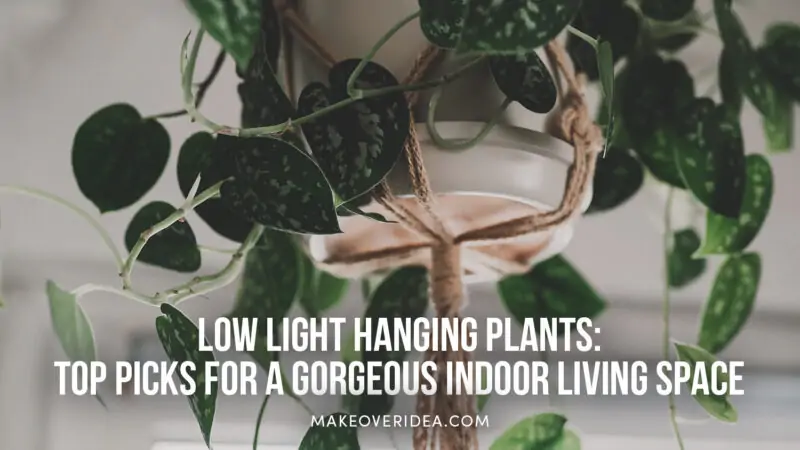
Looking to bring some greenery into your home, but worried about the low light conditions? Fear not! There are plenty of low light hanging plants that can thrive in dimly lit areas. Not only do they add a touch of nature and beauty to any room, but studies have shown that indoor plants can also improve air quality and boost mood (source: NASA Clean Air Study).
In this article, we’ll dive into the world of the best low light hanging houseplants – from understanding what qualifies as low and bright light to care for these beauties. We’ve even included some FAQs at the end!
What are the Best Low Light Levels for Indoor Hanging Plants
Understanding Lower Light Conditions
When it comes to indoor lighting, “low-light conditions” refer to areas where there’s minimal natural or artificial lighting available. This could be due to factors such as small windows or placement away from direct sunlight.
While most houseplants prefer bright indirect light from the sun (such as near a window), there are many options available for those with less-than-ideal low-light situations.
How To Measure Indoor Light Conditions
The easiest way is by using a lux meter – an inexpensive tool used for measuring illuminance levels within an area. For reference: 0-200 Lux = Very dark; 200-500 Lux = Dark; 500-1000 Lux = Dim/Indirect lighting or Medium light; >1000 Lux= Bright.
Top Low Light Hanging Houseplants (Spider Plant, Pothos & English Ivy)
Now let’s take a look at our top picks for indoor hanging foliage:
Spider Plant: A Great Choice to Grow in Low Light
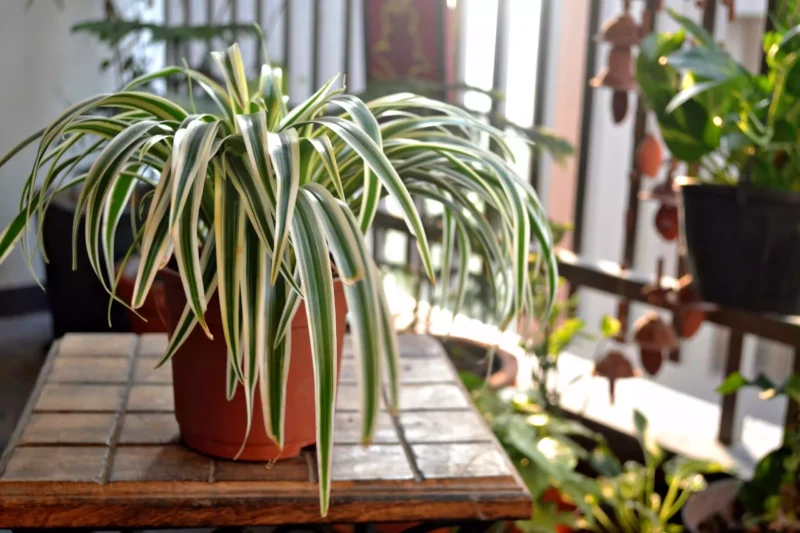
Spider plant has earned their popularity because it requires very little maintenance while being able to survive under various scenarios like high humidity levels and extreme temperatures. These adaptable plants produce long slender leaves adorned with delicate white flowers, which makes them a perfect choice for trailing houseplant varieties, similar in appearance to ivy. What’s more, they grow very well when exposed to filtered light.
Their sword-shaped leaves grow up to twelve inches long, so they will require ample space, but in addition to requiring less light, they also have the added benefit of purifying indoor air.
Pothos: A Favorite for Low Light Places
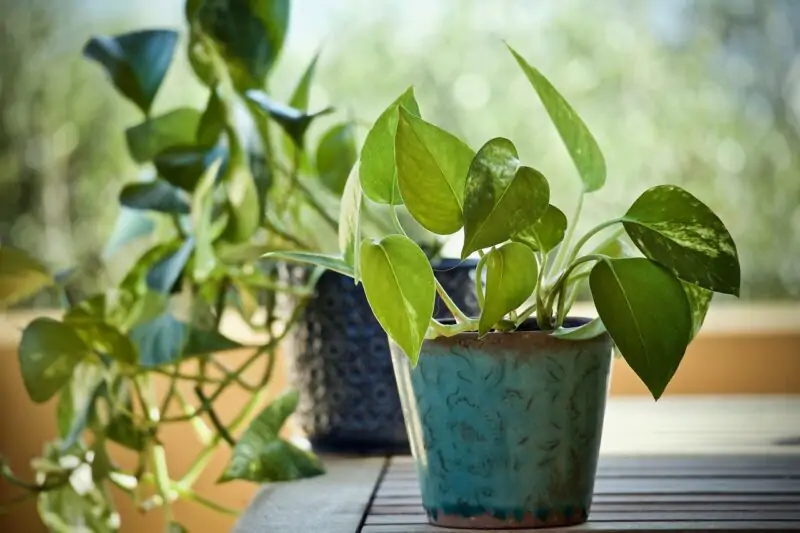
Pothos is a low-light champion and one of the easiest plants to grow indoors in lower light levels. These vines can be trained to climb walls or trail down when growing in hanging baskets, making them perfect for decorating any corner in your home.
In addition to making a great choice for a hanging basket, these beautiful plants also come in different shades like, for instance, golden pothos, which has vibrant yellow-green leaves with variegated patterns, enhancing their beauty even more. They are known for their ability to remove organic toxins such as benzene and formaldehyde and from indoor air, so not only will you enjoy their aesthetic appeal – you’ll breathe easier too! Last but not least, they tolerate low light and are ideal for indoor spaces.
English Ivy: A Classic And Elegant Option
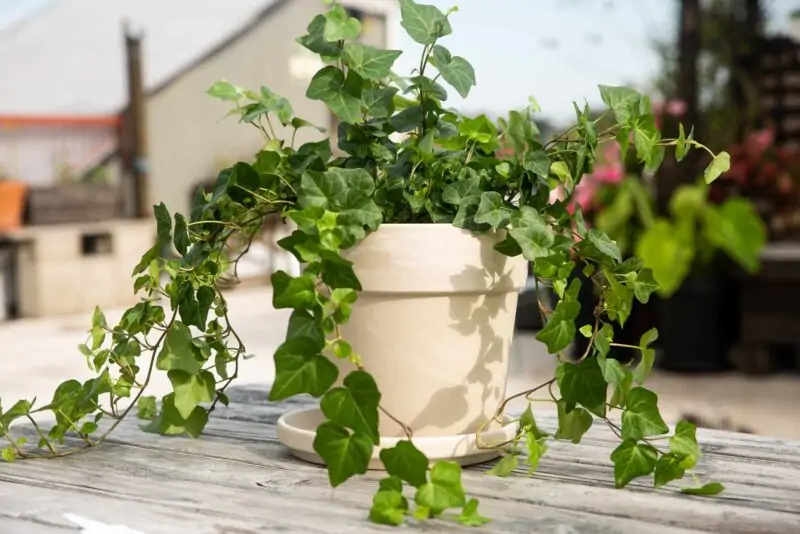
English ivy is another classic choice when it comes to low light foliage. It’s an evergreen climber that produces elegant green leaves with white veins running through them, which makes them ideal for adding some visual interest to dark corners. You can also place your English ivy plant in a hanging basket: these indoor hanging plants that don’t need sun will be a beautiful addition to your home.
This plant grows best in cooler temperatures (around 60-70°F) and prefers moist soil conditions with good drainage. You might also want to use a grow light for it for the best results.
Low Light Indoor Hanging Plants For Specific Rooms
While all these plants can work well throughout your house, there are certain varieties better suited for specific rooms:
Best Low-Light Hanging Plants For Bathrooms
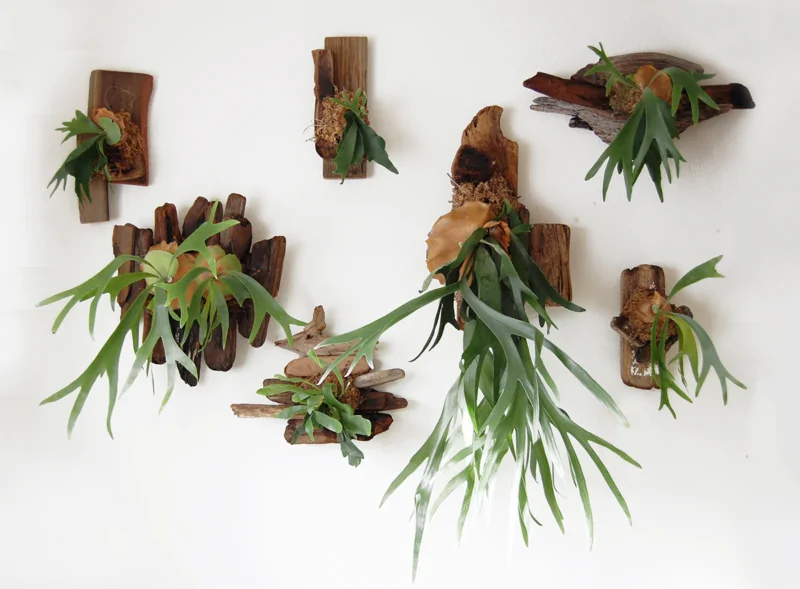
Bathrooms generally don’t get much natural sunlight exposure, hence requiring low maintenance trailing plant options perfectly matched by ferns like Staghorn Fern or Boston Fern. Not only these types are they extremely beautiful, they thrive in high humidity levels usually found within bathrooms while enhancing ambiance and improving oxygen levels, place them in beautiful hanging baskets for best results.
Low-Light Hanging Plants Ideal For Bedrooms
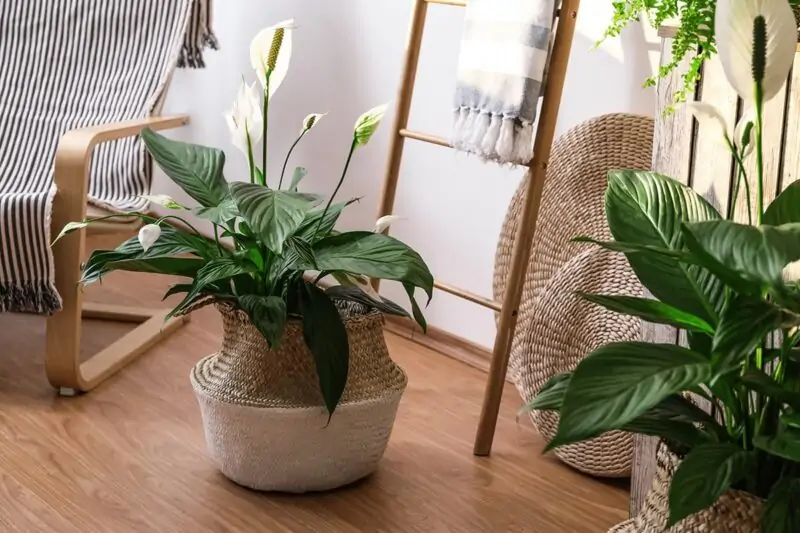
The bedroom needs serenity-inducing flowing greens, especially those with colors that blend well together, encouraging relaxation. Examples include Golden Pothos, Prayer plant (these plants get their name from folding their leaves), Peace Lily, and Peperomia plant all producing interesting shapes and textures while easily handling low light levels.
Caring For Your Low Light Plants in Hanging Baskets
Caring for the hanging plants for low light on our list requires little effort aside from regular maintenance like watering and pruning. Below are some tips to create the best indoor conditions to keep your low light hanging plants healthy:
Watering And Fertilizing Low Light Plants
The key with most indoor houseplants is to avoid overwatering, and this applies doubly so when dealing with plants that grow in low light. As a general rule of thumb, wait until the top inch or two of soil has dried out before subsequent waterings – you’ll be less likely to overdo it. Remember that plants can handle being slightly underwatered much easier than having to do with excess water.
When it comes to fertilization for growing plants, only feed your beauties once every month throughout their growing season, which usually falls between spring and summer months.
Pruning And Maintaining Your Indoor Greenery
Pruning isn’t just for keeping vining plants looking neat; it helps stimulate growth by removing dead leaves or sections that aren’t thriving anymore. Cut back any unhealthy stems at an angle using clean shears, ensuring minimal tissue damage.
Another essential aspect of maintaining these beautiful indoor hanging plants involves wiping their foliage gently with a damp cloth weekly, getting rid of accumulated dust and preventing possible pest infestations.
Styling Your Low Light Hanging Plants
Hanging planters have become very popular nowadays due to their aesthetic appeal, but there are multiple ways you can style your green friends around your home. You could add variety by mixing up different types together on a single setup, like pothos vines and spider plant foliage running down from the same planter holders. Alternatively, try incorporating other decorative items such as macrame hangers, showcasing simplicity and elegance while blending perfectly with the overall room decor. Any plant will looks absolutely adorable in hanging baskets that incorporate macrame!
FAQs
Plants like Spider Plant, Ponytail Palm, and Lipstick Vine, will be perfect choices for a hanging pot you plan to place in a room where your cats are. All of these plants pose no harm to felines, making them ideal choices.
Most varieties thrive well under artificial lighting typically found within homes, constantly replenishing their energy needs through photosynthesis.
Different plants have different needs, so the answer depends on the specific plant and your home’s humidity level. Typically, once every 1-2 weeks is a good starting point for tropical plants – it adjust as needed based on how quickly the soil dries out.
Pothos grows incredibly fast under any lighting conditions while remaining relatively easy to maintain. This is one of the best indoor hanging plants ever!
Yes! Some options include ferns and English ivy (hanging baskets are the only viable place for it), although it’s best to check with your local gardening center, experienced gardeners who live nearby, or nursery or to see what species thrive in your particular climate.
Such excellent low light plants as the Spider Plant and Golden Pothos are very adaptable, making them perfect choices, along with other leafy greens like Devil’s Ivy and Snake Plants.
Conclusion
Low light hanging plants present great alternatives when dealing with less than ideal indoor lighting situations. With such an extensive list of greenery options available today, ranging from Spider Plant, Pothos, and Ivy, finding one suited for both functionality and aesthetic appeal shouldn’t be too difficult, especially using this guide as a reference.